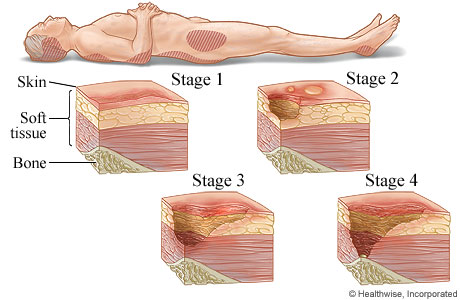Pressure ulcers, also known as bedsores or pressure sores, are injuries that can develop on the skin and underlying tissue due to prolonged pressure on a particular area of the body. These wounds can be painful and challenging to heal, leading to severe complications such as infections and sepsis. Knowing the different stages of pressure ulcers is essential to identify and treat them properly. In this blog, we'll discuss the four stages of pressure ulcers and why it's essential to be familiar with them.
4 Stages Of Pressure Ulcer
Stage 1 Pressure Ulcer
A stage 1 pressure ulcer is the mildest form of pressure injury. It's characterized by a reddened, inflamed, or discolored area of skin that doesn't turn white when pressed. The skin may feel warm or cool and may be painful or itchy.
Causes and risk factors of stage 1 pressure ulcers include prolonged pressure on a particular body area, such as the back, buttocks, hips, or heels. Other factors that can increase the risk of developing a stage 1 pressure ulcer include limited mobility, poor nutrition, dehydration, and medical conditions that affect blood flow, such as diabetes and peripheral artery disease.
Prevention and pressure ulcer treatment of stage 1 pressure ulcers include; relieving pressure on the affected area by changing positions frequently, using specialized cushions or mattresses, and avoiding tight clothing or bedding that can create friction. Good nutrition and hydration, maintaining skin hygiene, and avoiding smoking are also essential. Treatment may include topical ointments, dressings, or wound care, depending on the severity of the ulcer. With prompt treatment, stage 1 pressure ulcers can heal within a few weeks.
Stage 2 Pressure Ulcer
A stage 2 pressure ulcer is a more severe pressure injury affecting the skin and underlying tissue. It's characterized by a shallow, open wound that may look like a blister, abrasion, or shallow crater. The wound may be pink or red and may contain fluid or pus.
Causes and risk factors of stage 2 pressure ulcers include the same factors as stage 1, as well as friction and shear forces. Friction occurs when the skin rubs against a surface, while shear forces occur when the skin moves in one direction, and the underlying tissues move in another direction.
Prevention and treatment of stage 2 pressure ulcers include the same measures as stage 1 and additional steps to protect the wound and prevent infection. These may include covering the wound with pressure ulcer treatment dressings, cleaning the wound regularly, and avoiding harsh chemicals or irritants. Treatment may also involve antibiotics or other medications to prevent or treat an infection. With proper care, stage 2 pressure ulcers can heal within a few weeks to a few months.
Stage 3 Pressure Ulcer
A stage 3 pressure ulcer is a severe pressure injury affecting the skin, underlying tissue, and muscle. It's characterized by a deep, open wound that may expose bone or other structures. The wound may look like a deep crater and have a foul odor.
Causes and risk factors of stage 3 pressure ulcers are the same as the previous stages, but they may also include poor nutrition, dehydration, and medical conditions that affect the immune system.
Prevention and treatment of stage 3 pressure ulcers involve the same measures as previous stages, but treatment may be more aggressive and can involve surgery. Treatment may include removing dead tissue, applying dressings or other wound care products, and using medications to control pain and prevent infection. Healing time for stage 3 pressure ulcers can vary widely depending on the severity of the wound and the individual's overall health. In some cases, healing may take several months or longer.
It's essential to seek prompt medical attention for stage 3 pressure ulcers to prevent further complications and promote healing.
Stage 4 Pressure Ulcer
A stage 4 pressure ulcer is the most severe form of pressure injury. It's characterized by a deep, open wound that extends through the skin, underlying tissue, muscle, and bone. The wound may expose tendons, joints, or other structures, and there may be a significant amount of dead tissue or debris.
Causes and risk factors of stage 4 pressure ulcers are the same as the previous stages, but they may also include more complex medical conditions, such as spinal cord injury, paralysis, or advanced cancer.
Prevention and treatment of stage 4 pressure ulcers involve the same measures as previous stages, but treatment is often more complex. It may involve surgical intervention, such as skin grafts or flap surgery. Treatment may also involve specialized wound care products, antibiotics, and other medications to manage pain and prevent infection.
Healing time for stage 4 pressure ulcers can vary widely, and some wounds may never fully heal. It's crucial to seek prompt medical attention for stage 4 pressure ulcers to prevent life-threatening complications, such as sepsis or osteomyelitis.
Knowing pressure ulcer stages is essential in order to identify and treat these injuries promptly. With proper prevention and treatment, pressure ulcers can often be healed, and further complications can be prevented.
Conclusion
Pressure ulcers are a common and often preventable injury that can be particularly harmful to individuals with limited mobility or medical conditions that affect their blood flow. Knowing the four stages of pressure ulcers is essential for promptly identifying and treating these injuries.
Stage 1 pressure ulcers are the mildest form, while stage 4 is the most severe. Treatment and prevention of pressure ulcers involve relieving pressure on affected areas, maintaining good nutrition and hydration, and practicing proper wound care.
It's essential to seek medical attention promptly for pressure ulcers, particularly stage 3 and stage 4 ulcers or bedsores, to prevent further complications and promote healing. Most pressure ulcers can be prevented or healed with proper care and attention, improving a person’s quality of life and overall health outcomes.



.webp)

.avif)